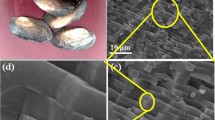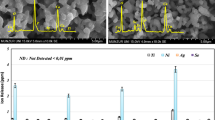Abstract
Hydroxyapatite/silver nanocomposites have been designed and synthesized as an engineering material for biomedical applications. The hydroxyapatite matrix was synthesized by a sol–gel method and, subsequently, the Ag nanoparticles were deposited by heterogeneous precipitation followed by two different reduction routes: thermal or chemical. Both sets were studied and compared and, in all cases, the metal nanoparticles appear perfectly isolated and attached to the surface of the hydroxyapatite. The average metal particle size is below 10 nm, allowing an important contact surface between silver and the microorganisms. The antimicrobial behavior against common bacteria showed a high effectiveness, well above the commercial level, as well as against yeast, in the case of the chemically reduced sample. Due to the nanocomposite microstructure, only a negligible portion of metal was released to the lixiviated liquid after the biocide tests, minimizing the risk of toxicity. These nanocomposites offer a solution to the infections on the surface of implants, one of the main problems in reaching a suitable level of osseointegration.










Similar content being viewed by others
References
Torrecillas RR, Moya JS, Diaz LA, Bartolome JF, Fernandez A, Lopez-Esteban S. Nanotechnology in joint replacement. Wiley Interdisciplinary Reviews: Nanomedicine. 2007;1:540–52.
Chen W, Liu Y, Courtney HS, Bettenga M, Agrawal CM, Bumgardner JD, Ong JL. In vitro anti-bacterial and biological properties of magnetron co-sputtered silver-containing hydroxyapatite coating. Biomaterials. 2006;27:5512–7.
Socransky SS, Haffajee AD. Dental biofilms: difficult therapeutic targets. Periodontology. 2002;28:12–55.
Patel R. Biofilms and antimicrobial resistance. Clin Orthop Relat Res. 2005;437:41–7.
Moya JS, Lopez-Esteban S, Pecharroman C. The challenge of ceramic/metal (micro- and nano-) composites. Prog Mater Sci. 2007;52:1017–90.
Fahrenholtz WG, Ellerby DT, Loehman RE. Al2O3–Ni composites with high strength and fracture toughness. J Am Ceram Soc. 2000;83:1279–80.
Williamson RL, Bruck HA, Wang XL, Watkins TR, Feng YZ, Clarke DR. Residual strains in an Al2O3–Ni joint bonded with a composite interlayer. J Am Ceram Soc. 1998;81:1541–9.
Diaz M, Bartolomé JF, Requena J, Moya JS. Wet processing of mullite/molybdenum composites. J Eur Ceram Soc. 2000;20:1907–14.
Wildan M, Edrees HJ, Hendry A. Ceramic matrix composites of zirconia reinforced with metal particles. Mater Chem Phys. 2002;75:276–83.
Xiang X, Zu XT, Zhu S, Wang LM. Optical properties of metallic nanoparticles in Ni-ion-implanted α-Al2O3 single crystals. Appl Phys Lett. 2004;84:52–4.
Díaz M, Barba F, Miranda M, Guitián F, Torrecillas R, Moya JS. Synthesis and antimicrobial activity of a silver-hydroxyapatite nanocomposite. J Nanomater. 2009;2009:498505.
Miranda M, Fernández A, Díaz M, Esteban-Tejeda L, López-Esteban S, Malpartida F, Torrecillas R, Moya JS. Silver-hydroxyapatite nanocomposites as bactericidal and fungicidal materials. Int J Mater Res. 2010;101:1.
Legerps RZ, Traity OR, Legeros JP, Edward K, Shirra WP. Apatite crystallites: effects of carbonate on morphology. Science. 1967;155:1409–11.
Noro T, Ito K. Biomechanical behaviour of hydroxyapatite as bone substitute material in a loaded implant model. On the surface strain measurement and the maximum compression strength determination of material crash. Biomed Mater Eng. 1999;9:319–24.
Ylinen P, Raekallio M, Taurio R, Vihtonen R, Vainionpää S, Partio EK, Törmälä P, Rokkanen P. Coralline hydroxyapatite reinforced with polylactide fibres in lumbar interbody implantation. J Mater Sci Mater Med. 2005;16:325–31.
Hao L, Savalani MM, Zhang Y, Tanner KE, Heath RJ, Harris RA. Characterization of selective laser-sintered hydroxyapatite-based biocomposite structures for bone replacement. Proceedings: Mathematical, Physical and Engineering Sciences. 2007;463:1857–1869.
Palazzo B, Sidoti MC, Roveri N, Tampieri A, Sandri M, Bertolazzi L, Galbusera F, Dubini G, Vena P, Contro R. Controlled drug delivery from porous hydroxyapatite grafts: an experimental and theoretical approach. Mater Sci Eng C. 2005;25:207–13.
Krisanapiboon A, Buranapanitkit B, Oungbho B. Biocompatibility of hydroxyapatite composite as a local drug delivery system. J Orthop Surg. 2006;14:315–8.
Ravelingien M, Smets N, Mullens S, Luyten J, Vervaet C, Remon JP. Local drug delivery from hydroxyapatite ceramic fibres. 4th European Conference of the International Federation for Medical and Biological Engineering, IFMBE Proceedings. 2009;22:2269–2272.
Venugopal J, Prabhakaran MP, Zhang Y, Low S, Choon AT, Ramakrishna S. Biomimetic hydroxyapatite-containing composite nanofibrous substrates for bone tissue engineering. Phil Trans R Soc A. 2010;368:2065–81.
Qian P, Jiang F, Huang P, Zhou S, Weng J, Bao C, Zhang C, Yu H. A novel porous bioceramics scaffold by accumulating hydroxyapatite spherules for large bone tissue engineering in vivo. I. preparation and characterization of scaffold. J Biomed Mater Res A. 2010;93A:920–9.
Bonfield W. Designing porous scaffolds for tissue engineering. Philos Transact A Math Phys Eng Sci. 2006;364:227–32.
Liu JK, Yang XH, Tian XG. Preparation of silver/hydroxyapatite nanocomposite spheres. Powder Technol. 2008;184:21–4.
Percival SL, Bowler PG, Russell D. Bacterial resistance to silver in wound care. J Hosp Infect. 2005;60:1–7.
Pourbaix M. Atlas of electrochemical equilibria in aqueous solutions. Houston (Texas): National Association of corrosion Engineers; 1974.
Thomas S, Nair SK, Jamal EMA, Al-Harthi SH, Varma MR, Anantharaman MR. Size-dependent surface plasmon resonance in silver silica nanocomposites. Nanotechnology. 2008;19:075710.
Esteban-Cubillo A, Diaz C, Fernandez A, Diaz LA, Pecharroman C, Torrecillas R, Moya JS. Silver nanoparticles supported on α-, η- and δ-alumina. J Eur Ceram Soc. 2006;26:1–7.
Arumugan SK, Sastry TP, Sreedhar B, Mandal AB. One step synthesis of silver nanorods by autoreduction of aqueous silver ions with hydroxyapatite: an inorganic–inorganic hybrid nanocomposite. J Biomed Mater Res A. 2007;80A:391–8.
Pal S, Tak YK, Song JM. Does the antibacterial activity of silver nanoparticles depend on the shape of the nanoparticle? A study of the gram-negative bacterium Escherichia coli. Appl Environ Microbiol. 2007;73:1712–20.
Panáček A, Kvítek L, Prucek R, Kolář M, Večeřová R, Pizúrová N, Sharma VK, Nevěčná T, Zbořil R. Silver colloid nanoparticles: synthesis, characterization, and their antibacterial activity. J Phys Chem B. 2006;110:16248–53.
Esteban-Cubillo A, Pecharromán C, Aguilar E, Santarén J, Moya JS. Antibacterial activity of copper monodispersed nanoparticles into sepiolite. J Mater Sci. 2006;41:5208–12.
Kim JS, Kuk E, Yu KN, Kim JH, Park SJ, Lee HJ, Kim SH, Park YK, Park YH, Hwang CY, Kim YK, Lee YS, Jeong DH, Cho MH. Antimicrobial effects of silver nanoparticles. Nanomed Nanotechnol Biol Med. 2007;3:95–101.
Cabal B, Torrecillas R, Malpartida F, Moya JS. Heterogeneous precipitation of silver nanoparticles on kaolinite plates. Nanotechnology. 2010;21:475705.
Sondi I, Salopek-Sondi B. Silver nanoparticles as antimicrobial agent: a case study on E. coli as a model for gram-negative bacteria. J Colloid Interface Sci. 2004;275:177–82.
Ayala-Núñez N, Lara-Villegas H, del Carmen Ixtepan Turrent L and Rodríguez-Padilla C. Silver nanoparticles toxicity and bactericidal effect against methicillin-resistant Staphylococcus aureus: nanoscale does matter. Nanobiotechnology. 2009;5:2–9.
Acknowledgments
This work was supported by the Spanish Ministry of Science and Innovation (MICINN) under the project MAT2009-14542-C02 and by the Spanish National Research Council (CSIC) under the PIE Project 200860I118. Miriam Miranda has been supported by the Government of the Principality of Asturias under the Severo Ochoa Program.
Author information
Authors and Affiliations
Corresponding author
Rights and permissions
About this article
Cite this article
Miranda, M., Fernández, A., Lopez-Esteban, S. et al. Ceramic/metal biocidal nanocomposites for bone-related applications. J Mater Sci: Mater Med 23, 1655–1662 (2012). https://doi.org/10.1007/s10856-012-4642-2
Received:
Accepted:
Published:
Issue Date:
DOI: https://doi.org/10.1007/s10856-012-4642-2




